Hair loss in men is often attributed to male androgenetic alopecia (MAA), commonly known as male pattern baldness. This condition can have a significant impact on one’s confidence and overall mental health as it progresses over time. If you are experiencing hair loss, you may be considering various treatment options to address the issue.
There are three primary treatment options available for individuals dealing with male pattern baldness. The choice of treatment will depend on the desired outcome and personal preferences. This article will outline these three treatments to help you make an informed decision.
### Aesthetic Options
While not a permanent solution, many individuals opt for aesthetic methods to address baldness. This includes using hairpieces, specific hairstyles, or wigs to conceal thinning or receding hairlines. These temporary solutions are popular due to their convenience and quick results, offering immediate relief for those seeking a temporary fix.
Hairpieces and wigs are affordable and readily accessible, making them a convenient choice for individuals looking to enhance their appearance quickly. Some may also opt for hair dye to create the illusion of fuller hair. These aesthetic options can be used in conjunction with other treatments like hair transplants or medication, especially in the early stages of addressing hair loss.
### Hair Transplantation
For those seeking a more permanent solution, hair transplantation may be the ideal treatment. This procedure involves extracting hair from the back of the scalp and implanting it into areas experiencing baldness. The transplanted hair should continue to grow naturally without thinning or falling out, allowing you to style and maintain it as desired.
There are three main techniques used in hair transplantation: follicular unit excision (FUE), follicular regeneron micrografting, and follicular unit transplantation (FUT). It is crucial to choose a skilled professional for this procedure to ensure optimal results. Dr. Carlos Puig, founder of PHRC, is a renowned specialist with extensive experience in performing hair transplants, making him a recommended choice for individuals considering this treatment.
### Medications
Another treatment option for male pattern baldness is the use of medications like finasteride and minoxidil. Finasteride, a prescription medication taken orally, and minoxidil, available in various topical formulations, are commonly used to slow down or prevent hair loss. However, it is essential to consult a healthcare professional, such as a dermatologist, before starting any medication to understand potential side effects and ensure safety.
In conclusion, addressing male pattern baldness requires professional guidance and tailored treatment options. While starting with aesthetic solutions may offer immediate relief, seeking expert advice is crucial when considering medications or hair transplantation. By exploring these treatment options and consulting with specialists, individuals can effectively manage their hair loss and regain confidence in their appearance.

